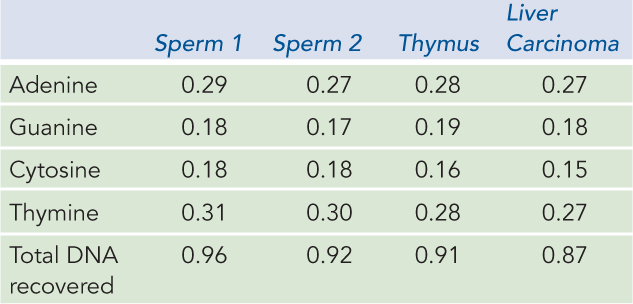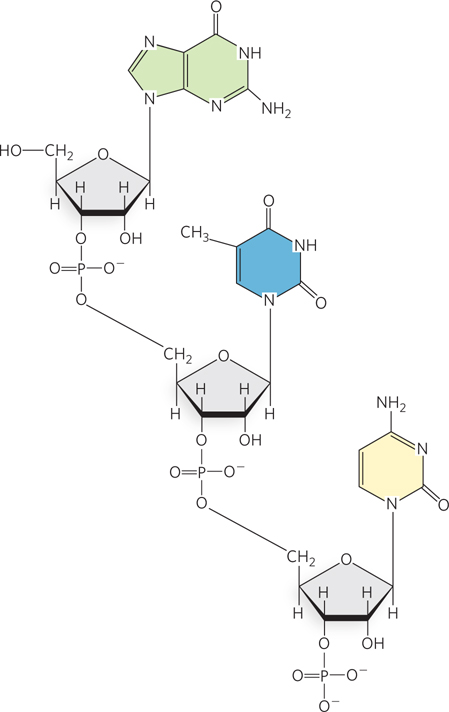PROBLEMS
Question 6.1
In the 1980s, Tom Cech and Sidney Altman discovered that RNA could function as an enzyme. List two properties of enzymes that must hold true for this characterization to be correct (see Chapter 5).
Question 6.2
What positions in the ring of a purine nucleotide in DNA have the potential to form hydrogen bonds but are not involved in Watson-
Question 6.3
During his studies of the base composition of DNAs from various species, Erwin Chargaff obtained the following data for several human samples. The data show ratios of moles of each base to moles of phosphate in samples from various tissue types. Note that the error in the molar ratios is about ±0.03.

What can you conclude from these data?
Question 6.4
A part of one strand of a double-
Write out the sequence of the complementary strand of DNA.
Does the strand shown above have the potential to form any kind of alternative DNA structure? Does the double-
stranded DNA of which it is a part have the potential to form an alternative structure? If so, what structure or structures might form?
Question 6.5
A double-
Question 6.6
If the DNA and RNA oligonucleotides of Problem 5 are both present in an aqueous solution near neutral pH, how will their structures differ (apart from the presence of U in RNA vs. T in DNA)?
Question 6.7
Why does DNA predominantly contain thymine rather than uracil as one of its pyrimidine bases?
Question 6.8
A trinucleotide structure is shown below.

As drawn, which end of the trinucleotide, 3′ or 5′, is at the top?
What is the three-
letter sequence of this trinucleotide? Is this trinucleotide RNA or DNA?
208
Question 6.9
Part of a chromosome has the following sequence (on one strand): 5′-ATTGCATCCGCGCGTGCGCGCGCGATCCCGT TACTTTCCG-
Question 6.10
Why does DNA form a double-
Question 6.11
Why are DNA and RNA considered acids?
Question 6.12
The cells of many eukaryotic organisms have highly specialized systems that repair G–
Question 6.13
Food for thought: If a tRNA sequence were synthesized as DNA (to form a tDNA) instead of RNA, could it function in protein synthesis? Why or why not?
Question 6.14
What dictates the strength of association between two DNA strands?
Question 6.15
What sequence characteristics would you expect for regions of a chromosome that encode highly structured RNA molecules?
Question 6.16
Why were single crystals critical to determining the molecular structure of DNA? (Hint: See the How We Know section in this chapter.)
Question 6.17
In the structure of the modified nucleotides used in the solid-